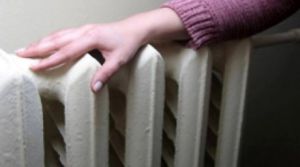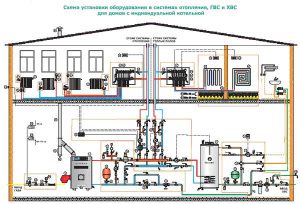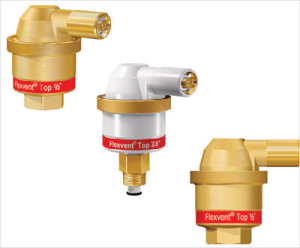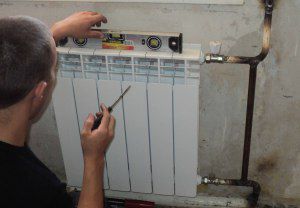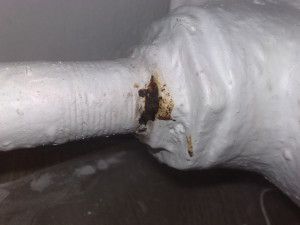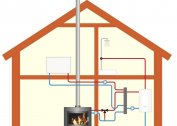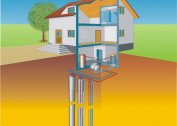It happens that the heating system ceases to function and forces residents to freeze. Worst of all, when a heating problem is detected during the winter cold season. The reasons for the failure of heat supply are various, and their essence is most often incomprehensible to a simple layman. But if you familiarize yourself with our recommendations, it will be easy for you to recognize and eliminate malfunctions in the heating system in order to protect your home from unpleasant surprises.
Signs of poor heating
When the rooms are not heated enough in winter, this is felt immediately. Problems with heating in the apartment make themselves felt by discomfort for the inhabitants, the appearance of dampness on the walls and obscure noises spreading through metal pipelines throughout the house.
Any problems with the heating system can be characterized by a number of signs:
- the system as a whole is poorly functioning;
- heat supply on different floors is not the same;
- the batteries in one room are hot, in the other barely warm;
- the “warm floor” system heats up unevenly;
- noise and bubbling in pipes;
- coolant leaking from pipes or radiators.
Causes of malfunctions in heating
Most residents of urban apartments believe that they do not need to know the design of engineering systems. Any problems of central heating that appear in their high-rise building must be solved by the employees of the management company. And it is right. It is better if only one responsible owner will deal with all the affairs. Indeed, in an apartment building, heating problems often arise precisely because of unauthorized interventions in the functioning of the heating system.
But individual homeowners are forced to understand the problems with heating in a private house and keep the situation under their control. The owner of the house should at least in general terms know about the causes of the problems and be able to fix them.
The following causes may cause problems with the heating system:
- the system is not designed correctly;
- equipment does not meet design requirements;
- the system is out of balance due to unauthorized connections;
- installation made poorly;
- air plugs interfere with the circulation of the coolant;
- radiators are not installed correctly;
- pipelines have become unusable;
- the tightness of the connections is broken.
Let us consider in more detail each of these reasons and ways to eliminate heating problems in an apartment and in a private house.
Errors in the design of the heating system
The development of a heating system project must be given due attention, so that in the future the problems of heating a private house do not poison everyday life. Attempts to save on competent design turn into troubles. For example, when starting a fully mounted system, problems with heating radiators are suddenly detected, some of which are not heated. So, the system was originally designed incorrectly and will have to be redone.
Design can only be entrusted to specialists who will take into account many factors.Among them: the layout of the house, the volume of heated rooms, the degree of heat loss, etc. It is also important to plan the necessary slope of horizontal sections of pipelines. Also, the main technical parameters of the required equipment can be determined only on the basis of heat engineering calculations.
For reliable heating of the house, the heating boiler must have a capacity of at least 1 kW for every 10 m² of floor space with ceiling heights of up to 3 m.
Inappropriate home heating equipment
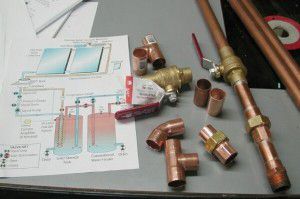
With the current wide range of heating equipment, it is easy to make a mistake and get the wrong one. To avoid problems in the heating system, it is necessary to focus on the compliance of all its elements with the approved project. You need to buy radiators only of that type and with the number of sections as planned. All pipe fittings, control valves and stopcocks must be mutually compatible.
Problems with heating in a private house often arise due to poor circulation. Circulation pumps help increase the speed of the coolant in the pipes. But you need to choose the right pump model correctly so that no noise in the pipes appears during its operation.
When arranging modern housing, old iron pipes are increasingly replaced by more practical metal-plastic and polypropylene ones. The absence of problems in each specific heating system will depend on their compliance with the given project conditions. Although plastic pipes are lightweight and easy to assemble, it is best to entrust the specialist with the correct selection and subsequent installation of these products.
It is important to know that not all types of plastic pipes are suitable for heating systems. Some of them under the influence of hot water, some may deform or burst.
Unbalanced heating system
Serious problems with heating in an apartment building arise when tenants are taken for the repair and redevelopment of their apartments. The spontaneous, uncontrolled installation of new radiators and underfloor heating leads to an unbalanced system. As a result, circulation in the system is disrupted, on some floors the batteries are hot, and on others the residents freeze. The management company’s specialists can balance the distribution of coolant in the risers, but heating problems in individual apartments still remain.
If the neighbors changed their heaters and took off the thermostats, it is not surprising that water will simply not go through the pipes into your apartment. And it will be possible to solve such a problem with heating only by removing the thermostat also at home.
Another opportunity to really increase the flow of heat into your apartment is to follow the example of your neighbors and change the batteries. If you install aluminum or bimetallic instead of cast iron, their heat transfer will be much better.
It is forbidden to arbitrarily change radiators, you need to get permission!
The heating system can also be unbalanced in a private house. Then the radiators located closer to the boiler heat up more than the distant ones. The balance will have to be restored in this way: cover the control valves and limit the flow of coolant to the nearby radiators, so that more heat gets to the far ones.
Poor installation of the heating system
It happens that a new, newly installed radiator does not want to heat up.
Others, standing in the system before and after it, heat up normally, but this one does not. The reason is poor circulation of the coolant. The cause of a problem with the heating radiator could be the oversight of the installer.Probably, when welding a polypropylene pipe, he overheated it too, and as a result of reflow, the inner diameter decreased. In such cases, the installer is obliged to redo his poor-quality work for free.
In order not to cause problems with the heating system, all pipes and fittings included in its composition must represent a reliably mounted design.
Air congestion in heating
If the batteries are not heated in any of the rooms, it means that the air accumulated in the system prevents the free movement of the coolant. Airlock can form due to many reasons, among which are:
- air enters during the descent of water from the system and its subsequent filling;
- oxygen is released from the water when heated;
- a faulty expansion tank creates a local zone of reduced pressure;
- air is sucked into the system through connections with impaired tightness;
- diffusion of air through the surface of plastic pipes.
Air bubbles can accumulate either at the highest point in the piping system, or in only one of the radiators. Then the bottom of the battery will be hot and the top will remain cold. The presence of air in the pipes also provokes the appearance of unpleasant sounds of gurgling. Most often, heating appliances on the top floor of the building stop heating.
The more complex the heating system in your home is, the slower it should be filled so that there are no air jams.
Due to air bubbles, not only the heat supply through the piping system is stopped, but also the corrosion of metal elements begins. The smooth operation of the circulation pump is also disturbed.
The use of simple technical devices will help get rid of the problem of clogging the heating system with air jams.
The most effective way to remove air from a closed heating system can be considered the use of automatic air vents. If they are mounted at once in several problem areas, then air from each group of system elements will be bleed off as it accumulates.
In addition to automatic, there are manual air vents (Mayevsky crane). Such a device is installed at the end of the radiator located on the highest of the floors. You can learn how to use it from the video presented here.
How to bleed air through a Majewski tap
Depending on how the heating system is arranged, sometimes it is necessary to release it from the air through an expansion tank in the attic. The circulation pump is also able to help drive air jams out of the system.
Incorrectly installed radiators
The issue of proper battery installation is most relevant for private homeowners, since they themselves have to regulate the heating in their home. Self-replacement of radiators should be treated with responsibility, because installing them without preliminary calculations can add unnecessary problems to the heating system.
For example, the installation was done according to the instructions, and some of the radiators worked half-heartedly. It turns out that it is skewed and the coolant cannot fill it whole. And the reason is that a heavy multi-section radiator was hung on only two brackets, although it would be more reliable to use four. As a result, the metal structures bent and the inner tubes deformed.
The reliability of the radiator also depends on its location. The bottom edge of the battery should be raised 10 cm above the floor, 2-3 cm of free space should remain between the radiator and the wall.
Each radiator should hang on reliable brackets without sagging, play and distortions.
Decrease clearance in old heating pipes
In the old Khrushchev’s, problems in the heating system are obvious and predictable. There, the service life of pipelines has long expired, and therefore they become the cause of not only a decrease in heat, but also accidents. For many decades, pipes are so clogged with deposits that they are not able to provide normal circulation. The solution should be cardinal - replace all pipes.
In addition, a decrease in pressure in the system is caused by the formation of scale on the heat exchanger of the boiler. The use of too hard water leads to such consequences. To prevent a similar problem with heating devices, special reagents are added to the system to soften the water.
Leaking heating pipe
The cause of interruptions in the heating network is often leakage caused by corrosion or poor-quality pipe connections. If the leakage is visible, then the problem with heating in the apartment can be solved faster. It is bad if the connection is hidden in the thickness of the wall or in the floor. Then you have to cut off the entire flowing branch of the pipeline and mount a new one.
How to seal a leak when the need arises? To do this, it is recommended to keep in stock simple plumbing devices for clamping pipes of the appropriate diameter. In extreme cases, you can make a homemade clamp: wrap a piece of soft rubber in the place of leakage, and then tighten it tightly with wire.
If a leak is found at the junction of the radiator sections, you will have to bandage this area with a strip of cloth, which you must pre-soak with moisture-resistant glue. It is permissible to use special sealant, "cold welding" and other means.
The proposed methods of dealing with the problem of the flow of the heating system are only temporary, and overhaul will subsequently be required.
Before the start of the heating season, inspect all pipelines and radiators in the apartment for leaks. Owners of an autonomous heating system should test its performance in the fall.
Finally, you can advise: for all problems with heating in an apartment or in your private house, contact a specialist. Only they know how to correctly design a system, install a boiler, perform pipe routing and connect radiators.
Do not save on the quality of the purchased equipment, so as not to splurge on repeated repairs, if a cheaply bought crane breaks down and floods the room.
Learn to correctly identify the causes of heating problems and start to eliminate them competently. In other words: think seven times - repair once!
